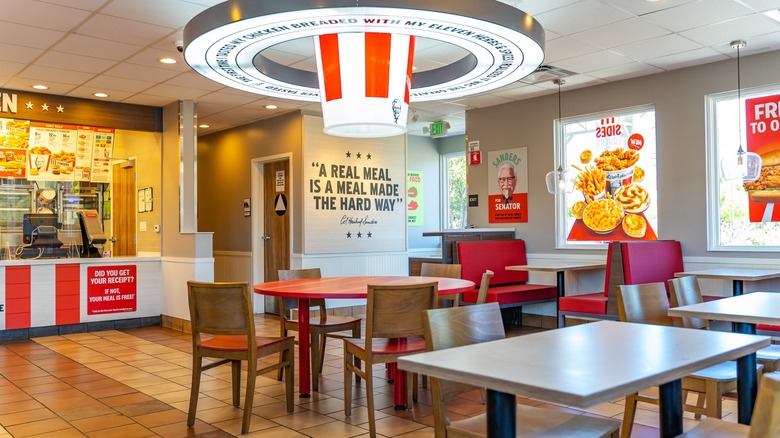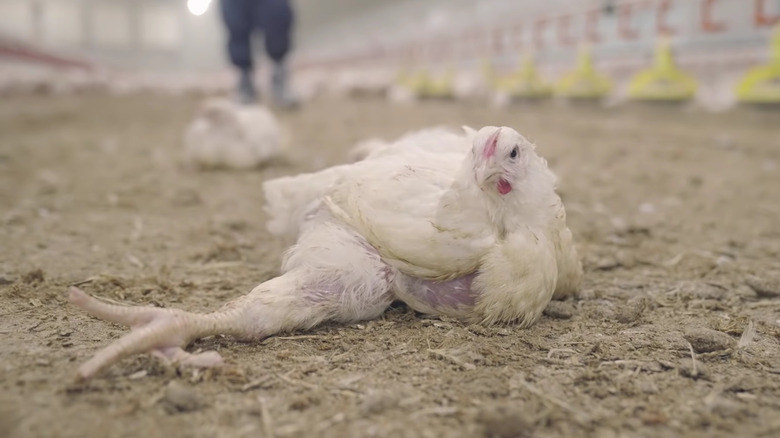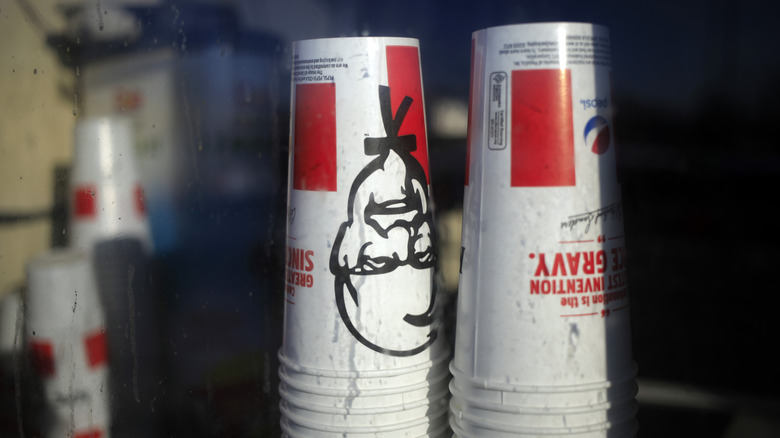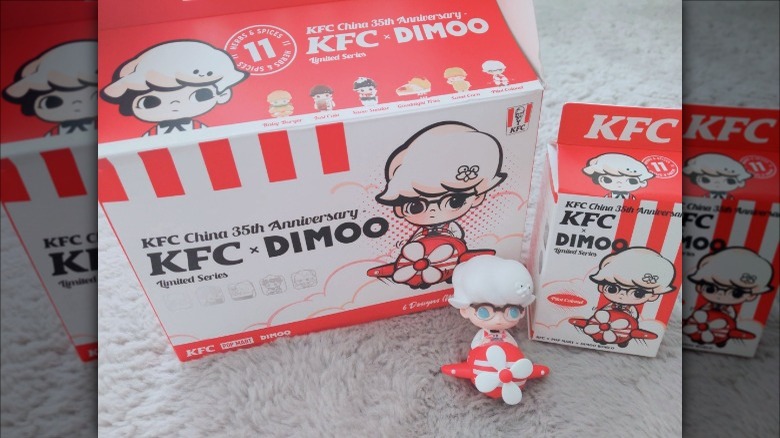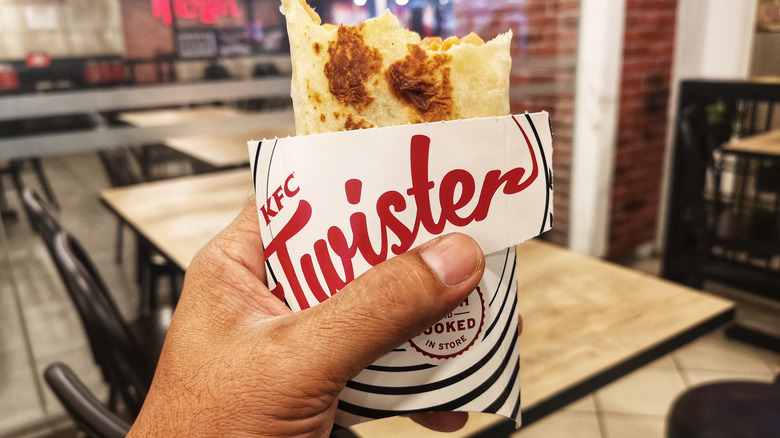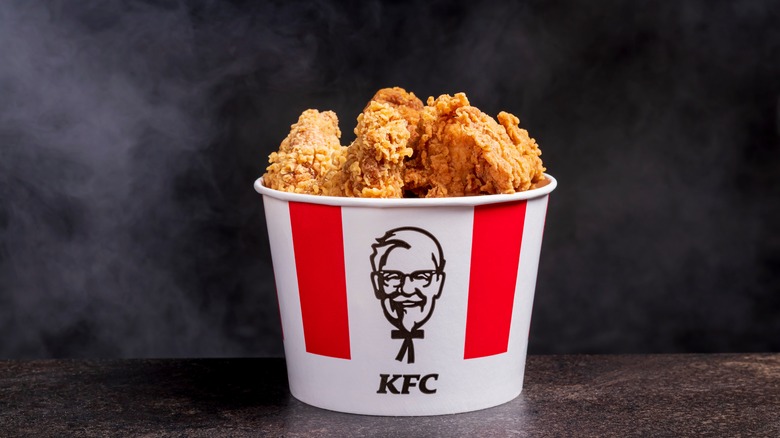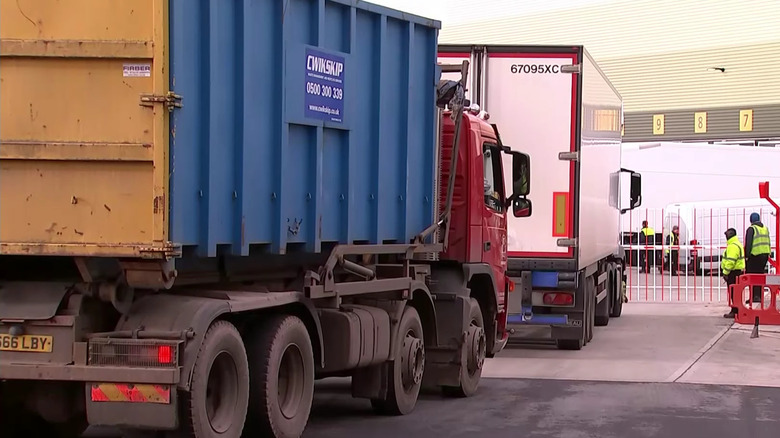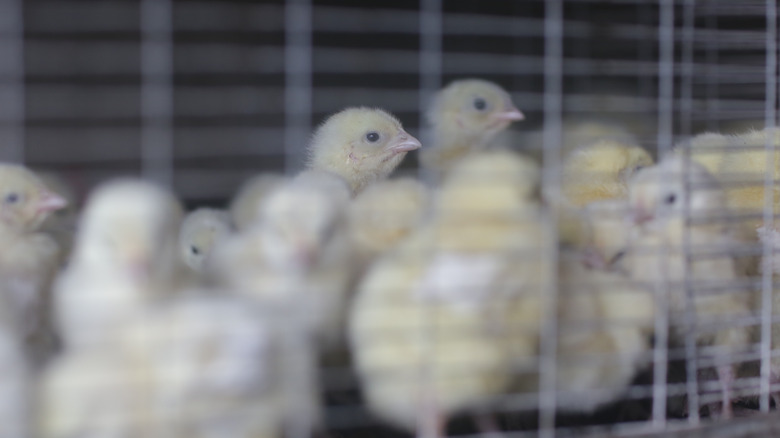What You Should Know Before You Eat At KFC Again
KFC is the fifth most popular dining brand in the United States, according to YouGov. Around 99% of Americans have heard of it and 70% like it. This prominence is mirrored globally; KFC has some 23,000 locations in over 135 different countries. It's even the third most valuable quick-service restaurant worldwide — only Starbucks and McDonald's are worth more, reports Statista.
However, just because something is popular does not necessarily mean it is good. Criticisms have been leveled at the brand before, with some customers dismissing KFC, and its offerings, as unappetizing. Unfortunately for the brand, some of these concerns may be justified, since there are several unsavory truths about the company. These facts range from poor living conditions for the chickens that end up in KFC's buckets to instances of life-altering illnesses being transmitted by the chain's offerings. Be warned: you will not be licking your fingers after reading this one.
KFC's chicken welfare standards have been labeled as misleading
The main criticisms leveled at KFC center around its animal welfare. There have been numerous controversies throughout KFC's history, usually precipitated by footage released by animal welfare groups. In 2004, footage was released by PETA detailing horrific animal abuse in a chicken factory that had previously won KFC's Supplier of the Year.
In recent years, KFC has tried to appear like it was improving chicken welfare standards. The company signed the Better Chicken Commitment in 2019, a set of standards that seeks to improve all stages of farmed chickens' lives from birth to slaughter. KFC was also placed in World Animal Protection's top tier for improvements made to chicken welfare in 2021.
Unfortunately, KFC's claims of improved chicken welfare are somewhat misleading. This was highlighted by a promotional video made by KFC in conjunction with YouTuber Niko Omilana. This video showed chickens living in good conditions at one of its supplier's farms. Two months after this promotion was released, investigators from VFC — a vegan food brand — visited the same farm and released a video that detailed horrific living conditions including overcrowding, widespread disease, and a lack of environmental enrichment. Speaking to The Guardian, Matthew Glover, VFC's cofounder, said: "This is the most disingenuous marketing campaign we have seen for a long time. This portrayal of chicken farming is utterly misleading and seeks to reassure the public that all is well, when nothing could be further from the truth."
Fecal bacteria has been found in KFC's ice
In a 2017 episode of "Watchdog," an investigative journalism program produced and aired by the BBC, it was revealed that ice served at seven out of 10 investigated KFC restaurants in the United Kingdom were contaminated with fecal bacteria. Five of these samples contained significant levels of the bacteria, called fecal coliforms. "Watchdog" also found six Burger King restaurants and three McDonald's restaurants in the U.K. serving ice that contained fecal coliforms.
The presence of fecal coliforms in the ice indicates that the water used to make it was likely contaminated with the feces of employees. Tony Lewis, head of policy and education at the Chartered Institute of Environmental Health, explained this to The Independent: "It's extremely worrying. When we're finding the sorts of numbers we're finding here, you have to look at the people making the ice, handling the ice, which they then transfer into customers' drinks. And then you also have to look at hygiene failure with potentially the machines themselves: are they being kept clean?"
The Washington State Department of Health reports that while fecal coliforms themselves are not likely to cause illness, their presence indicates that dangerous pathogens could also be present — something which should give all KFC customers second thoughts before they order an ice-filled soda.
Some of its menu items are incredibly unhealthy
The vast majority of people understand that KFC — as well as other fast food — is unhealthy. Just how unhealthy some KFC menu items are, however, may surprise people. Take the chicken pot pie, for example. This innocuous-looking item, which can be bought for as little as $5 when on offer, contains a staggering 1,680 milligrams of sodium as well as 15 grams of saturated fat.
To put this into perspective, the U.S. Food and Drug Administration recommends adults consume less than 2,300 milligrams of salt per day. This means that one KFC pot pie contains nearly three-quarters of an adult's daily recommended salt intake. What's more, The British Heart Foundation states men should consume no more than 30 grams of saturated fat per day and women only 20 grams. Again, one KFC chicken pot pie accounts for the vast majority of this allowance.
Unsurprisingly, KFC's fried chicken is also full of fat. 160 grams of KFC's Extra Crispy Chicken Breast contains 23 grams of fat and 95 milligrams of cholesterol.
A KFC promotion led to excessive food waste
At the beginning of January 2022, KFC launched a meal promotion in China with the popular toy maker Pop Mart. When customers ordered certain set meals, they received a mystery box containing one of six limited edition Dimoo dolls.
Almost immediately after the promotion was launched, there were reports of customers buying numerous meals in order to complete the set of dolls. One individual reportedly spent $1,649 on over 100 meals in an attempt to collect all of the dolls. During this pursuit of the toys, eating the actual meals became less of a priority. As a result, huge amounts of food waste resulted from the promotion.
Following this promotion, the company has made strides in regard to food waste. In June 2022, KFC joined forces with FareShare, a food redistribution charity. It is estimated that around 12 million KFC meals are saved from landfill every year thanks to this partnership. In June 2023, KFC China announced plans to expand its food bank program, doubling the number of stores taking part. Whether these commitments and recommendations translate into less wasteful promotions remains to be seen.
The food has made people sick
Food poisoning is a scary prospect for any customer, especially when eating high-risk items like chicken. Unfortunately, there have been numerous instances of illnesses occurring after customers have eaten at KFC, sometimes with catastrophic consequences.
The most widely reported incident occurred in Australia in 2005. Monika Samaan was seven when she visited KFC with her family. After she and her brother shared a Twister Wrap, both were soon suffering from salmonella poisoning. As a result of eating the contaminated wrap, Samaan slipped into a six-month-long coma. When she woke it became apparent she had suffered severe brain damage. Despite appealing, KFC was forced to payout over $8 million in damages.
Other instances of food poisoning have also been reported at KFCs across the world. In 2019, 247 KFC customers fell ill on a single day after eating at a KFC restaurant in Ulaanbaatar, Mongolia. A high-profile food poisoning case in London involved celebrity magician Dynamo. He sued KFC after food at one of its London restaurants made him so ill that he was hospitalized.
KFC's gravy is made from fryer scraps
KFC hit headlines once again when it was revealed how the brand's gravy is made. The process involves crackling, which is the leftover scraps found at the bottom of a restaurant's deep-fat fryers. To make the gravy, this is mixed with water and other ingredients.
The practice of using crackling is not much different from how gravy has been made for centuries. Yet, the huge variety in how often the fryer oil is changed from restaurant to restaurant means KFC's practice can quickly become unsavory. Weeks or even months old frying oil can end up in the gravy. This is a disgusting prospect for any diner, especially when the oil isn't left to properly drain from the crackling.
Criticisms of KFC's gravy are nothing new. In fact, Colonel Sanders himself despaired at the quality of the brand's gravy when he visited a KFC restaurant in 1976. When presented with mashed potatoes and gravy, Sanders was reported by The New York Times as saying: "You have wallpaper paste. Next suppose you add some of this brown gravy stuff and then you have sludge. There's no way anyone can get me to swallow those potatoes." Given the chances of ingesting old fryer oil, perhaps we should all follow the Colonel's lead.
Healthy options are routinely discontinued
The entire KFC menu is, for the most part, unhealthy. This is because nearly all KFC products contain fried chicken which is packed with saturated fat and cholesterol.
To give KFC credit, it has attempted to introduce healthier, baked chicken in the past. The problem is that few people chose to order it. This was highlighted by Jenny Packwood, head of brand engagement at KFC U.K. and Ireland, who talked about KFC's failed baked chicken products with Sky News: "It didn't go brilliantly well. We tried and we failed to launch a non-fried product. It's no good launching a product which looks good nutritionally but then nobody buys. It doesn't improve the health of the nation and in terms of sustainability it is a disaster."
The abandonment of this £8 million, eight-year push to serve baked chicken highlights the difficulty brands like KFC face when trying to introduce healthier products. The only somewhat healthy menu item line that has proved somewhat successful is KFC's rice boxes and salads — which are not sold everywhere. Given the low demand for healthy alternatives, we wouldn't bet on other healthy options hitting restaurants any time soon.
In the U.K., KFC occasionally struggles with shortages
If animal abuses, poor nutrition, and questionable hygiene are not enough to put you off frequenting KFC, shortages might. These are not so much of an issue in the U.S., but in the U.K., KFC has suffered from several high-profile shortages.
The most infamous of these occurred in 2018 when over half of KFC's British outlets closed due to a shortage of chicken. The shortage resulted from KFC changing its delivery contract and the ensuing supply chain issues that arose. Not only did this mean some of the British public was deprived of KFC for days, but also that massive amounts of fresh chicken spoiled.
In 2021, a shortage of truck drivers, coupled with Brexit and the pandemic, also resulted in chicken shortages. A KFC spokesperson was recorded by The Caterer as saying: "Recent supply chain challenges have meant some of our restaurants are facing a few shortages," showing this incident's similarities with other shortages.
The chain still uses fast growing chicken breeds
The conditions many KFC chickens are kept in are abhorrent. Yet, this is only one part of the animals' suffering. Over the years, KFC — along with other fast food brands and grocery stores — have selectively bred chickens to grow unnaturally fast. Unsurprisingly, this results in a huge array of health problems for the chickens including losing the ability to walk, organ failure, and skeletal deformations.
KFC uses fast-growing chickens in order to minimize costs; the quicker chickens reach slaughter weight, the less money and resources must be spent on them. This approach works: half of the chickens used to create KFC products are slaughtered by the time they reach the age of 38 days.
The company claims that it desires a switch to slow-growing chicken breeds. Admittedly, the use of slow-growing chicken breeds is part of the Better Chicken Commitment signed by KFC. Yet, the company does not seem eager to make any drastic changes, until others in the industry commit to doing the same. This may delay the switch to healthier, slower-growing breeds.
